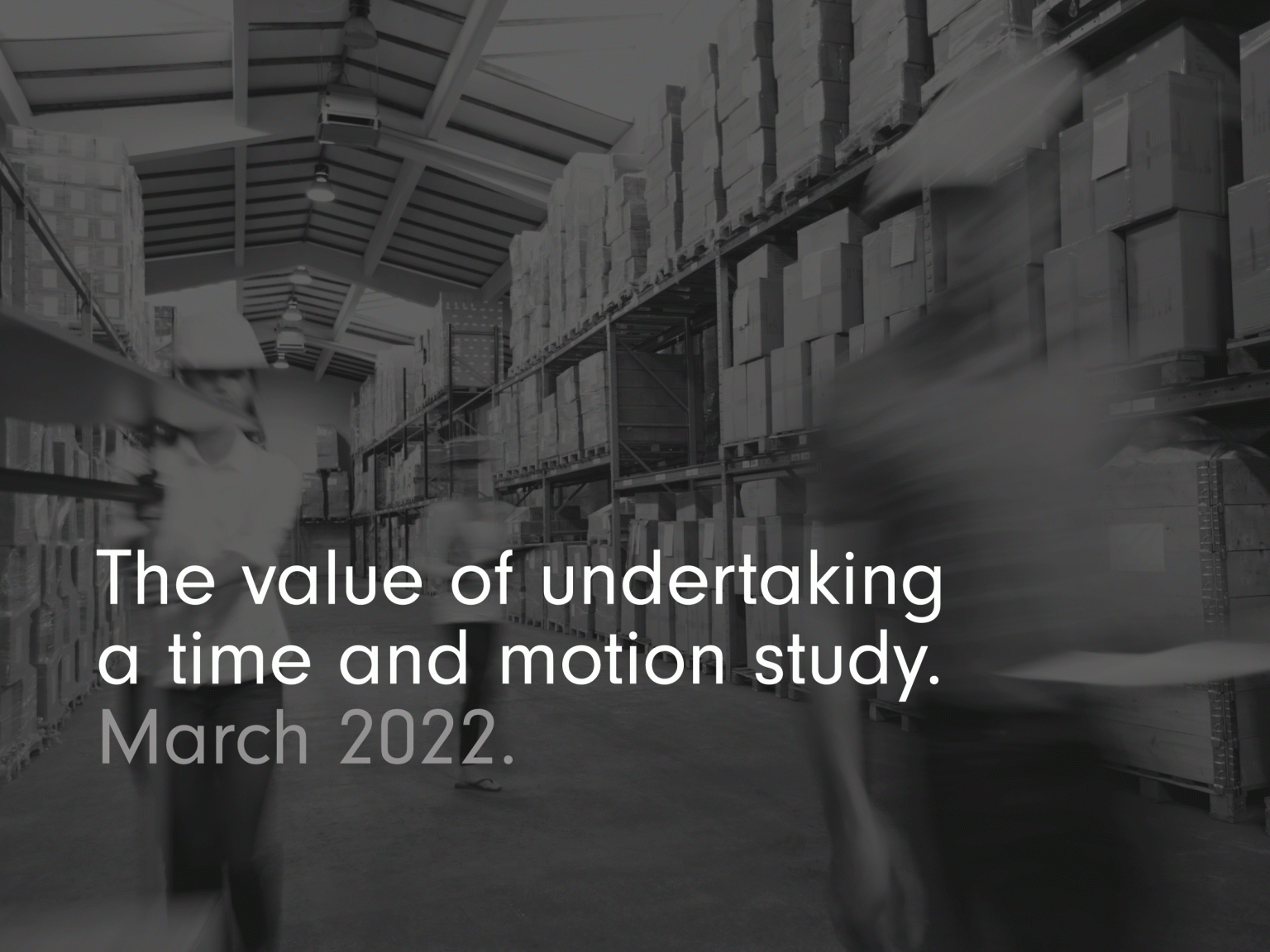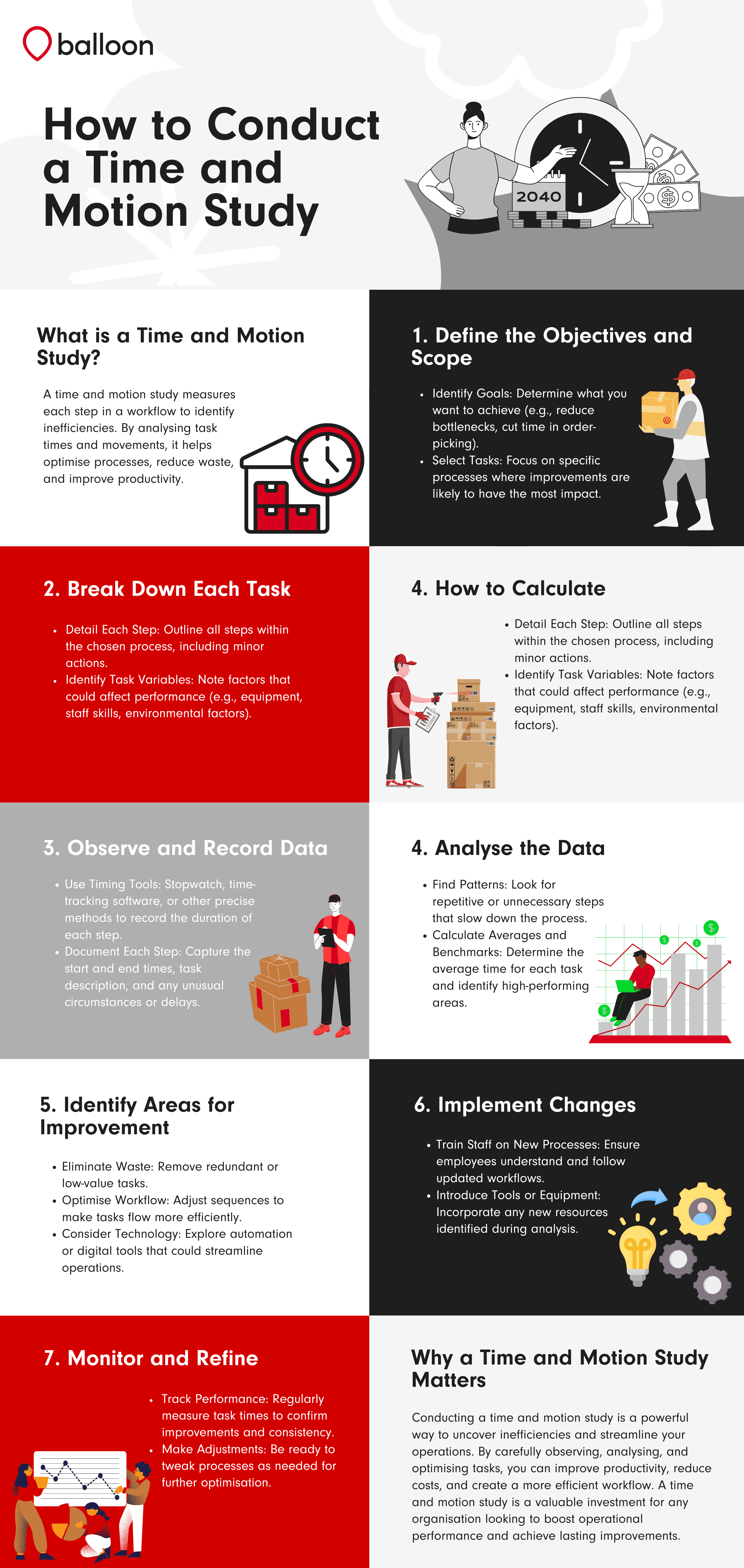The value of undertaking a time and motion study.

In the warehouse, the aim of undertaking a time and motion study is to improve processes and optimise performance.
Depending on the KPIs that you track in your warehouse, you can make those improvements across a number of areas. Perhaps you want to achieve more picks per operative per hour or improve receipt accuracy. Or maybe your goal is to increase the percentage of sales orders that you ship on time in full.
What is a Time and Motion Study?
A time and motion study is a business management technique that examines the efficiency of work processes and identifies areas for improvement. It involves the continuous monitoring of a task while it is being undertaken, typically by filming the task and timing each part using a stopwatch or the digital time code recorded during filming. The observed timings are then compared with those that can be achieved using alternative business processes or different technologies to accomplish the same task.
The study identifies the best aspects of the workflows being scrutinized and creates a set of standardized best practices for the workforce to follow. Based on the findings, a company can decide whether to change any technology, hardware, or business processes by weighing the additional costs against the potential savings or expected return in value.
Over time, the aggregation of marginal gains from these improvements can lead to significant cost savings, resulting in enhanced financial performance for the warehouse.
The stages of a time and motion study.
A time and motion study examines how efficient your processes are, with the objective of identifying how you can improve them. These are the main stages.
1. Monitor your existing method.
The first stage is to carefully examine a process you want to improve. In the warehouse, this involves closely monitoring and timing the task while it is being done.
2. Assess it against other options.
With an accurate breakdown of each part of the task, you can compare how long it takes with other ways of performing the task. In this way, you can find more efficient ways of doing things that make the overall workflow faster. This might mean using a different picking strategy so that workers travel less or implementing a technology solution that eliminates manual processes. Any additional costs and any potential savings are weighed up to decide on the expected overall return and to decide which improvements are most valuable.
3. Change the process.
Once you’ve decided on a change, you then implement it. You should standardise the improved workflow and deploy it for use by warehouse operatives going forward.
4. Check the outcomes.
After a period of time, you will want to check how successful your change has been. You will want to check your KPIs to see if your revised workflow has produced the desired results. As the marginal gains aggregate over time, the improvements begin to add up.
5. Repeat.
If you can only look at one workflow at a time, then the time and motion study process can be repeated for other areas in turn. This iterative approach brings continual improvements to the organisation.
The benefits of a time and motion study.
A time and motion study improves your workers’ efficiency and performance. By removing wasteful motions, they can complete tasks more quickly. This results in them being able to complete more tasks within a shift. Or you might instead direct them to workflows that simplify processes and use the most efficient sequence of actions, which in turn increases your overall productivity.
As you fulfil more orders, customer satisfaction improves. Since your warehouse efficiency is at its peak, your customers receive their orders as quickly as you have promised.
Time and motion studies can be used as a basis for incentivising staff – to boost productivity even more. You can standardise the time required for various tasks, like picking or replenishment, through a time and motion study. During peak periods, when you process more orders, it may be more economical for you to reward existing employees for improvements in their efficiency than to hire seasonal workers. Because you have established a standard basis, you can incentivise further improvements in productivity or reward those that over-achieve via bonus payments.
Conducting a time and motion study helps you plan your workforce requirements. In conjunction with your order data, you can forecast the number of workers required to complete the workload during the upcoming months. Based on the standard times for each task that you have from the time and motion study, you can calculate the number of operatives you’ll need to fulfil those orders. With accurate staffing requirements, you can pinpoint the staffing budgets you’ll need too.
Where warehouse tasks take longer or cost more than you expect, a time and motion study can help determine where the discrepancy lies. It identifies inefficiencies, which you can then adjust for, which allows you to progress and become more productive.
By conducting a time and motion study, you gain a standard set of tasks and workflows. These make it easy to train newly hired operatives and temporary staff on the best way to conduct the work. Being trained in best practice working methods means they work optimally, with no risk of picking up poor habits from co-workers.
As well as improvements to the actual tasks that a worker carries out, a time and motion study can identify improvements you can make to benefit the warehouse as a whole. It might be possible, for example, to adjust the layout of the warehouse to better facilitate movement. Or the study might indicate that moving the location of certain SKUs would improve your picking rates. Alternatively, you could alter the entire picking strategy so that you reduce travel time throughout the warehouse.
Ultimately, a time and motion study shows where you can speed up workflows and make substantial cost savings. The result is greater productivity and better financial performance.
For more information, read our guide to conducting a time and motion study, which includes a case study showing how a time and motion study Balloon conducted for a global tyre manufacturer predicted how the company could make efficiency gains of just under £100k a year.
Why not stay updated on LinkedIn?

Frequently Asked Questions.
A time and motion study analyses work processes to improve efficiency and productivity in warehouses. It examines how tasks are performed and how long they take, aiming to spot and eliminate inefficiencies.
It helps warehouse managers understand resource use, identify bottlenecks, cut labour costs, and boost overall efficiency. This results in faster order fulfilment and better customer satisfaction.
Start by choosing specific tasks or processes to analyze. Use tools like stopwatches or software to time each step. Observe employees and document their actions and methods. Analyze the data to find improvement areas.
Tools include stopwatches, video recording devices, motion-capture software, and specialized time study applications. These help accurately measure time and analyze movements to spot inefficiencies.
Ensure accuracy by conducting multiple observations at different times and under various conditions. Include a diverse group of employees in the study. Make sure conditions reflect normal operations for reliable data.
Techniques include optimising layout design, streamlining workflows, reducing unnecessary movements, implementing ergonomic practices, and using automation where possible. Training staff on efficient methods is also important.
Challenges include employee resistance, data collection inaccuracies, and the time required for thorough studies. Overcome these by communicating the benefits to employees, using reliable tools, and planning the study carefully.
Expected outcomes include reduced operational costs, increased productivity, faster order processing times, improved employee satisfaction, and higher accuracy in inventory management.
Conduct these studies periodically, annually or bi-annually. Also, initiate a study whenever there are significant changes in processes or equipment, or when persistent inefficiencies are observed. Regular studies help maintain high efficiency and adaptability to new challenges.